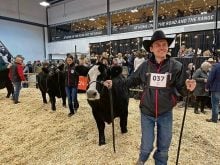An ear tag sensor system developed and validated for heat detection and health monitoring in the dairy industry by Agis Automatisering of the Netherlands is showing promise as a tool for early detection of respiratory disease in feedlot cattle in Canada.
The CowManager SensOor tag clips onto an Allflex radio frequency identification button to pick up ear movements associated with feeding and rumination. Ear movement is constant but irregular when the head is down while eating compared to a regular pattern of ear movement during rumination.
Data are transmitted every minute from the tag to a computer that translates the information into feeding and rumination minutes and summarizes it into one-hour periods. When an animal’s feeding or rumination time drops in comparison to the previous day or to its pen mates, an alert shows up on the computer. An app is available to receive the same alerts and data on a mobile device.
Read Also

What to know before you go to Agribition 2025
If you’re attending Agribition 2025, this is the place to find out about tickets, dates and what’s happening this year.
The correlation between the onset of sickness and changes in feeding behaviour is as early as seven days before cattle show clinical signs of illness, according to previous studies using the GrowSafe individual feed bunk system. It has also been well established that treating cattle in the early stages of lung infection improves cure rates and reduces weight loss, explains Dr. Barbara Wolfger, a veterinarian from Austria, who is currently a PhD candidate studying with Dr. Karin Orsel at University of Calgary Veterinary Medicine (UCVM).
- More from the Canadian Cattlemen: Lameness in feedlot cattle
Wolfger says the SensOor system is also of interest because it measures rumination time. The association between rumination time and early disease detection hasn’t been studied, but could aid in identifying conditions such as ruminal acidosis.
Working with Orsel and Dr. Edouard Timsit, she put the SensOor system to the test last summer in a validation study at Lacombe Research Centre to determine whether it could be a practical and effective tool to record feeding and rumination times.
Eighteen steers were fitted with SensOor tags to monitor feeding and rumination 24-7, while observers recorded feeding and rumination minutes for a total 233 hours during the same six-week period.
Compared to live observation, the system correctly recorded 92 per cent of feeding minutes and 51 per cent of rumination minutes. Ninety-two per cent of non-rumination events and 71 per cent of non-feeding events (rumination and other behaviours) were correctly calculated.
“A lot of rumination minutes were calculated by the system as feeding minutes, so the algorithm still needs a bit of adjustment. If adjusted to correctly recalculate those feeding minutes into rumination minutes we would actually get a pretty precise measurement of feeding and rumination,” Wolfger says.
A second trial was carried out at Lethbridge Research Centre last fall to assess the system’s practical application. The objective was to compare feeding and rumination behaviour of sick and healthy animals as monitored by the SensOor system. Thirty low-risk steers were fitted with tags, but only three were pulled for signs of respiratory disease by pen checkers who didn’t have access to the SensOor recordings. A healthy calf was pulled at the same time each of the sick calves were pulled to compare rumination and feeding time.
“We saw that sick calves had shorter feeding and rumination times than the healthy cattle and after treatment we saw feeding time increase quite dramatically, so the system seems to work really well,” Wolfger reports. “Even though the information isn’t 100 per cent accurate, we still get what we want — to detect calves that are sick.”
Unfortunately, no formal conclusions could be drawn from this study because of the unexpected low number of sick calves, but the research team feels the system has great potential for early respiratory disease detection.
She cautions producers to be careful when interpreting absolute numbers and percentages because on average the system recorded six minutes more feeding time per hour and three minutes less rumination time per hour than observed.
Regularly monitoring behaviour patterns over time would give producers a good indication of normal versus suspicious trends.
The company is working to improve and adjust the technology for the beef cattle industry and perhaps to develop a lighter-weight tag for calves, while the UCVM is hoping to secure funding for a large-scale study to prove the system’s ability to detect early stage of disease and test the system during very cold winter temperatures.
Easy to use
The reusable ear tags easily click on and off the Allflex RFID tags. No SensOor tags were lost during these trials. Wolfger recommends keeping tags at room temperature before clipping them onto the RFID tags when working outdoors in cold temperatures.
Reading distance is one drawback. The ear tags have to be within 100 metres of the router to maintain continuous data flow. However, when cattle are farther away, the tags save data for up to 48 hours and transmit it the next time the animal is within reach of the router.
The SensOor tags perform three functions and each requires its own software module to collect and summarize data. The system was originally developed for use with the fertility software module to detect heat in dairy cattle.
The health module summarizing feeding and rumination per hour and day was tested in this study for its potential as a tool for early disease detection in feedlot cattle.
The temperature function works with the health module, however, Wolfger wasn’t able to integrate this feature into early disease detection because it records ear skin temperature, not body temperature. In temperature-controlled environments, the ear skin temperature of an animal relative to the group in combination with feeding behaviour may be used to detect metabolic disorders and disease, but its practical application for cattle housed outdoors in the Canadian environment hasn’t been assessed.
The CowManager SensOor system has to be ordered directly from the manufacturer. As of August, a starter kit including one tag, the health module and co-ordinator for a computer was priced at CAN$109 per tag for up to 100 tags. There is a volume discount in 100-tag increments that drops the price down to $80 per tag for more than 5,000 tags. The router costs $731. The system, including the reusable SensOor tags, has an expected 10-year lifetime and five-year manufacturer’s warranty.
Product details and contact information are available on the company’s website, www.cowmanager.com. For more information on the trials, Wolfger can be reached by email.

















